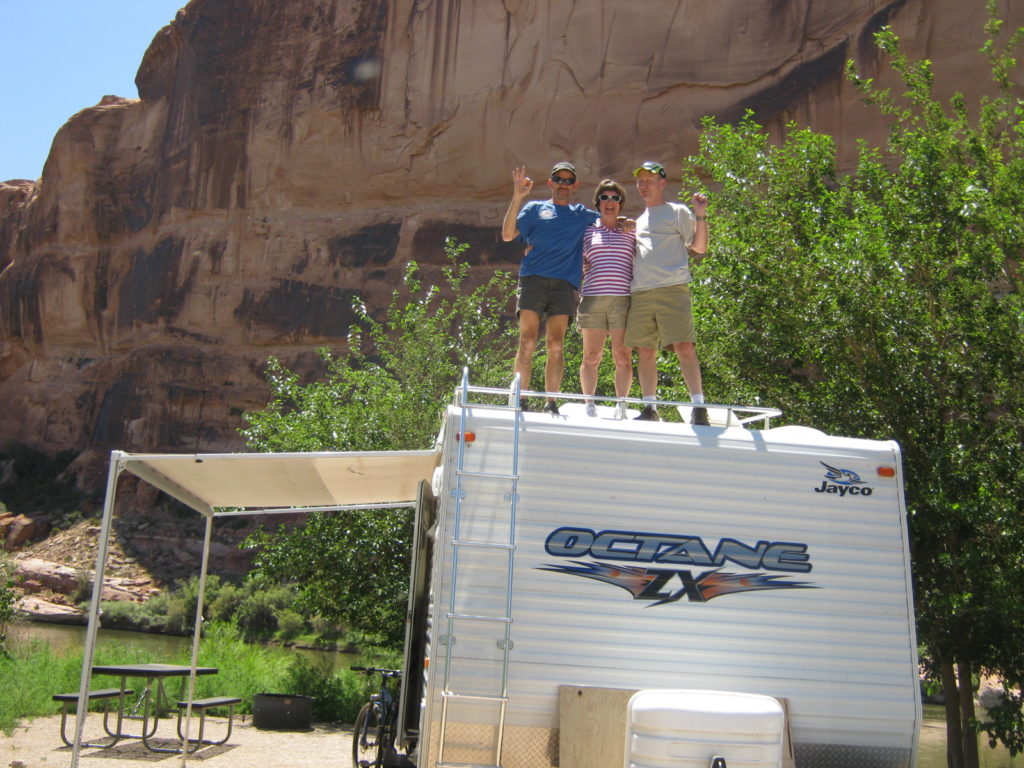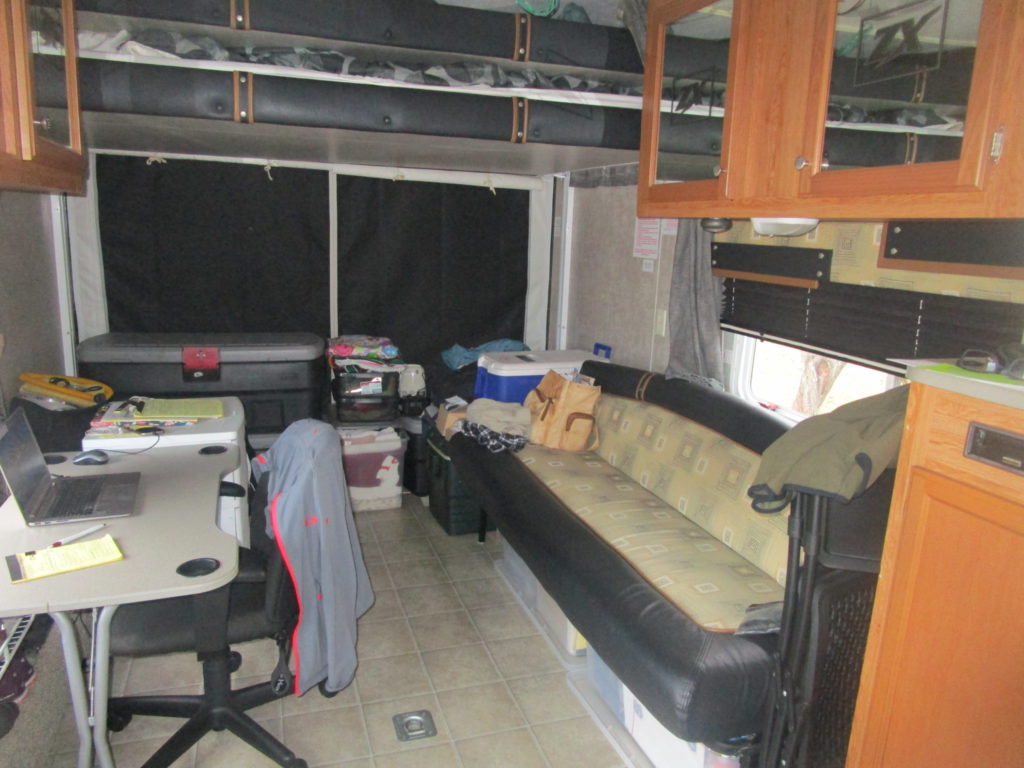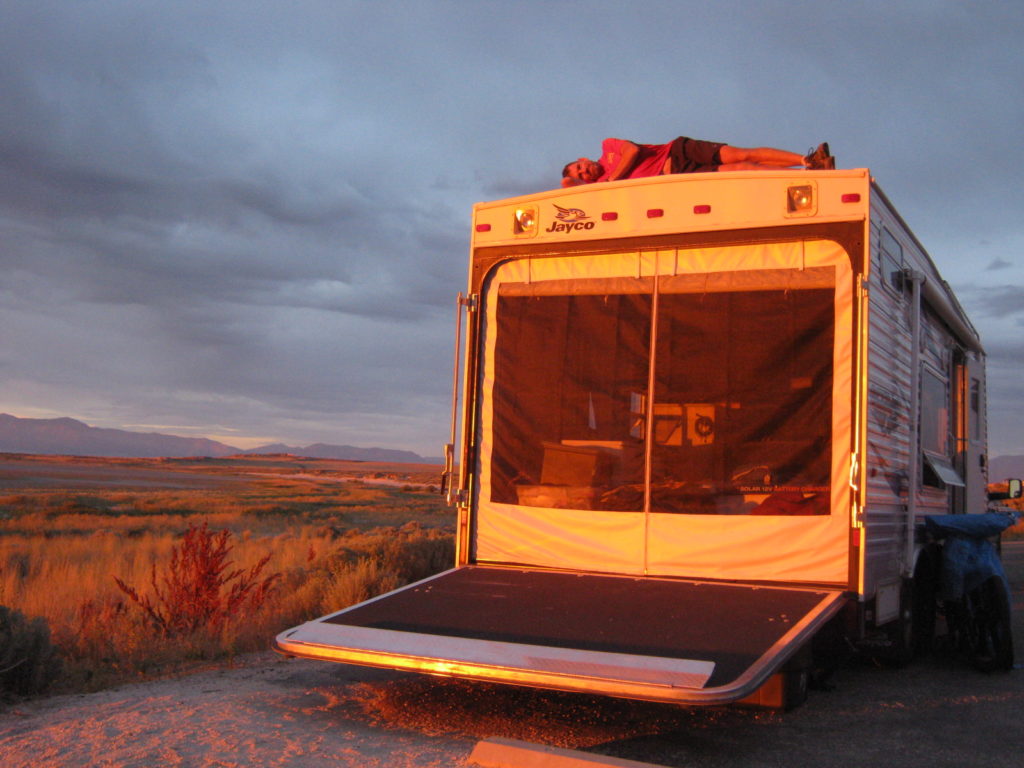We moved into our new Jayco Octane travel trailer when we returned from France in 2006. It’s a toy hauler, meaning it has space and structure for transporting toys like ATV’s and motorcycles. Our version of “toys” is orienteering and running gear, bicycles, paddles, camping stuff, and mountaineering equipment.
Everything about the design has been great for us. Big space, a bed that goes up and out of the way, a ramp in the back that opens everything to the outside (with a bug screen), solid construction. We started with the 19-foot version, figuring it looked pretty small sitting in the lot full of giant RV’s. If it didn’t hold everything we could always upgrade.
Here’s our trailer, a.k.a. “Howie” (for Home on Wheels – ie) … and friends!

This size has worked well for us and we appreciate that it fits in most campground spots. For a while we were wishing for a slide-out, until we removed the dinette seats and greatly improved the flexibility of the living space.

It’s a 3-season trailer, meaning we can’t really winter in cold places (although somehow we ended up in Flagstaff for the winter of 2020-21) but living on the road means we can generally pick and choose where we park and when. Roaming around to various adventures and jobs and projects and meeting up with family and friends, what more could we want?
We’ve done some renovating and adding to and removing things from Howie. The starting design relied on propane for the bulk of the higher-energy requirements, which is standard in the RV industry. There wasn’t any solar on the roof when we bought it, and the battery was fairly useless for boondocking. Over the years we improved our off-the-grid situation quite a lot, aiming for an all-electric travel trailer.
And now we have removed the propane altogether, yay! I wrote a blog post related to propane removal if you’re interested in reading more.
For anyone thinking of doing something similar, take a look at my blog post about electrification. It includes big and small changes you could make. There’s a focus on mobile living but it’s also applicable for larger (and stationary) homes.
Details of the following topics are available as well:
The refrigerator retrofit, part 1 and part 2, and then the upgrade to a new fridge
Electric cooking and switching to induction
Redoing the roof before upgrading the solar system
Our new lithium battery bank
All the solar we could put on the roof
Our AC and DC power systems and how we use the power we’ve got
The new awesome mini-split heat pump air conditioner/heater
As it stands now (since mid-2021), we have:
- 1580 watts of solar on the roof
- ~10.5 kWh worth of lithium batteries
- Magnum Energy MS4024 inverter (4000W, 24V)
- Unique solar-powered DC fridge (9.0 ft3, compressor), UGP-260L1
- Pioneer mini-split heat pump (heater/AC) (9000 BTU, 19 SEER), WYS009AMFI19RL-16
- Electric cooking: Induction cooktop, Instant Pot, electric kettle, microwave, toaster oven
- Three small electric space heaters
- Electric water heater (Camplux Pro ME40B mini tank electric water heater, 4 gallon)
- Zero propane (no tank refills), quieter heating and AC, cleaner air, and a safer home
- Total weight is about 8700 pounds (more or less, depending on how full the tanks are)
We can boondock (without an electricity hookup) indefinitely in most weather, needing to plug in only when it’s below freezing. In 2020 we went 198 days straight without connecting to shore power, including in 100 degree outside temperatures while running the air conditioner. We are more comfortable in a wider range of conditions than we have ever been while on the road.
There are more plans in the works, but we’ve completed the bulk of the conversions and we could not be happier with our all-electric travel trailer!
